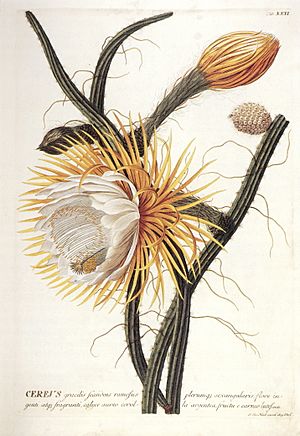Queen of the night facts for kids
Quick facts for kids Queen of the night |
|
|---|---|
 |
|
| Conservation status | |
| Scientific classification | |
| Genus: |
Selenicereus
|
| Species: |
grandiflorus
|
| Synonyms | |
|
Cactus grandiflorus L. (1753) Sp. Pl. 467 |
|
The Selenicereus grandiflorus is a special type of cactus. It is often called the Queen of the Night because its beautiful flowers only open for one night. People also know it as the night-blooming cereus or vanilla cactus due to its sweet smell.
This cactus comes from the Antilles, Mexico, and Central America. It's quite rare to find the true species growing in gardens. Many plants sold under this name are actually other types of cacti or mixes of different plants. It is sometimes confused with another cactus group called Epiphyllum.
Contents
What's in a Name?
The name Grandiflorus comes from Latin and means "large flowered." When Carl Linnaeus first described this cactus in 1753, it had the biggest flowers of any cactus known then. However, compared to some other Selenicereus species today, its flowers are actually a moderate size.
A Cactus with History
This cactus was one of the first cactus species to be grown by people. Carl Linnaeus described it in 1753. But it was known even earlier than that. Records show it was growing in the Royal Gardens at Hampton Court before the year 1700.
For a while, people weren't sure if the plant Linnaeus described was the same one we know today. But now, experts agree that the pictures we have show the real species.
Where the Queen of the Night Lives
The Queen of the Night cactus grows naturally in many places. You can find it across the Greater Antilles, which includes Cuba, Jamaica, and Puerto Rico. It also grows in Mexico, Guatemala, Belize, Honduras, and Nicaragua.
This cactus likes to climb on trees and rocks. It can be found at heights of up to 700 meters (about 2,300 feet). The plant can look very different depending on where it grows, especially in Jamaica. Some plants have smooth stems, while others have bumpy ones, even on the same plant!
How to Grow This Special Cactus
The Queen of the Night is an easy plant to grow. It grows quickly and can live on other plants (an epiphyte) or on rocks (a lithophytic plant). It needs soil that has a lot of humus, which is rich, dark soil from decomposed plants. It also needs enough water during the summer.
In winter, it's important to keep the plant warm. The temperature should not go below 5 °C (41 °F). This cactus grows best when it gets a lot of sunlight. Giving it extra light in early spring can help it grow flower buds.
The most exciting part is when it blooms! The flowers appear in late spring or early summer. They only open for one night a year and then wilt within a few hours. It's a truly special event to witness.
What the Queen of the Night Looks Like
This cactus has long, climbing stems that can reach over 10 meters (33 feet) in length. These stems are stiff and can form tangled masses. They also grow roots in the air, which helps them climb. The stems are usually 15–25 mm thick.
The stems have 7 or 8 low ridges, with wide, rounded spaces between them. Along these ridges are small, woolly spots called areoles. These are where the spines grow. The spines are usually 5 to 18 in number, and they can be up to 12 mm long. They are yellowish-brown and turn gray as they get older. The skin of the cactus is often a bluish-green color, sometimes with a purplish tint.
The Amazing Flowers
The flowers of the Queen of the Night are very large. They can be 17–22.5 cm (7–9 inches) long and even up to 38 cm (15 inches) wide! They have a wonderful smell, like vanilla and orange blossoms.
The outer petals of the flower are light brown or pinkish. The inner petals are white and shaped like a spear. Inside the flower, there are many stamens (the parts that produce pollen) and a long style (the central part).
The Fruit
After the flower fades, the cactus produces a fruit. The fruit is oval-shaped, about 5–9 cm long and 4.5–7 cm thick. It can be whitish, pink, yellow, or orange. The fruit is covered with small clusters of spines and hairs, but these fall off easily. The fruit is juicy.
Scientists recognize four main types of this species, called subspecies:
- ssp. donkelaarii
- ssp. grandiflorus
- ssp. hondurensis
- ssp. lautneri
Mixed-Up Cacti: Hybrids
Sometimes, different types of cacti can mix together to create a new plant. This is called a hybrid. One famous hybrid involving the Queen of the Night is called Selenicereus ×callianthus. This plant is a mix between Selenicereus grandiflorus and another species called Selenicereus pteranthus.
Many plants that people think are the true Selenicereus grandiflorus might actually be this hybrid. It looks very similar to Selenicereus pteranthus, but its stems are thinner, and its spines are longer and yellowish.
See also
 In Spanish: Selenicereus grandiflorus para niños
In Spanish: Selenicereus grandiflorus para niños


